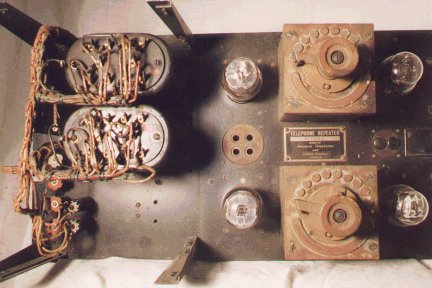 Welcome back to the second stage in the tour. Most of this page is
devoted to
small Private Automatic eXchanges (PAXs), ie local echanges which usually
had no connection to the public network. However, first a couple of
unusual public system
items. The unit on the right is a trunk line amplifier or "repeater".
Repeaters were situated at intervals
along the long trunk cables between cities. They were usually housed in
dedicated buildings although in
cities they were often in the same building as an exchange. Earlier
repeater stations used
valve amplifiers but the stations only needed to be around 15 miles
apart. However, later
buildings housed smaller equipment but were usually then required at
more frequent intervals,
such as every three miles. The STC amplifier shown here is of 1930's
design.
Welcome back to the second stage in the tour. Most of this page is
devoted to
small Private Automatic eXchanges (PAXs), ie local echanges which usually
had no connection to the public network. However, first a couple of
unusual public system
items. The unit on the right is a trunk line amplifier or "repeater".
Repeaters were situated at intervals
along the long trunk cables between cities. They were usually housed in
dedicated buildings although in
cities they were often in the same building as an exchange. Earlier
repeater stations used
valve amplifiers but the stations only needed to be around 15 miles
apart. However, later
buildings housed smaller equipment but were usually then required at
more frequent intervals,
such as every three miles. The STC amplifier shown here is of 1930's
design.
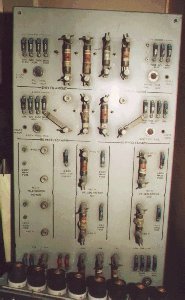 Another interesting rarity is this fuse panel from a VF Telegraph
station. Voice Frequency
telegraphs operated teleprinter networks over long distances and this
wartime panel is from
a derelict military radio station. I donated my VFT amplifier rack to
Bletchley Park so I
cannot show that to you.
Another interesting rarity is this fuse panel from a VF Telegraph
station. Voice Frequency
telegraphs operated teleprinter networks over long distances and this
wartime panel is from
a derelict military radio station. I donated my VFT amplifier rack to
Bletchley Park so I
cannot show that to you.
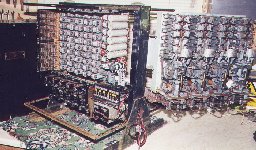 ATM 25 line pre-2000 Pax on the work bench, circa 1933. The rear gate
is swung around to
show the selectors. Rescued from an electricity board museum, believed
to have been used in a
sub station in Staines.
ATM 25 line pre-2000 Pax on the work bench, circa 1933. The rear gate
is swung around to
show the selectors. Rescued from an electricity board museum, believed
to have been used in a
sub station in Staines.
 GEC 50 line uniselector Pax, circa 1947
GEC 50 line uniselector Pax, circa 1947
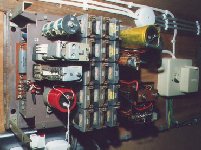 ETL/Plessey 10 line uniselector pax. This is a real miniature Strowger
exchange, based on one
uniselector and built into a small box no bigger than a shoe box. Circa
1966
ETL/Plessey 10 line uniselector pax. This is a real miniature Strowger
exchange, based on one
uniselector and built into a small box no bigger than a shoe box. Circa
1966
 ATE/Plessey 15 line uniselector pax. Fitted with tie line.
ATE/Plessey 15 line uniselector pax. Fitted with tie line.
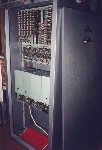 ATE/Plessey 25 line 2 motion selector pax. Contains 4 x 2 motion
switches, one of the
smallest 2 motion paxes of recent years. Rescued from a Scottish
distillery.
ATE/Plessey 25 line 2 motion selector pax. Contains 4 x 2 motion
switches, one of the
smallest 2 motion paxes of recent years. Rescued from a Scottish
distillery.
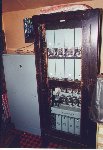 On the left is an STC 25 line uniselector pax of 1961, also rescued
from an electricity power
station where it was used to extend a large GEC Pax of several hundred
lines. On the right is
a GEC SE50 50 line pax of 1959, using type 4000 selectors.
On the left is an STC 25 line uniselector pax of 1961, also rescued
from an electricity power
station where it was used to extend a large GEC Pax of several hundred
lines. On the right is
a GEC SE50 50 line pax of 1959, using type 4000 selectors.
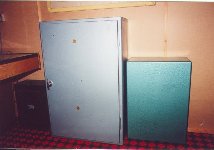 In the
centre is a
T&N 27 line Pax incorporating
a small ringing machine, circa 1966. On the right is a 20 line DeTeWe
pax using diode
signalling, ie push button phones with diodes working in combination
with the 3rd earth
return leg. Circa 1967. The small Pax on the left is a Siemens
all-relay Pax circa 1931. As this is one of the oldest PAXes I know,
and it does need some attention, I would be grateful to hear from
anyone who may have any technical knowledge of its operation, or in
particular, any technical wiring drawings etc. There are some closer
pictures here, of the outside, also the outside label and of the inside.
Please email me, Martin
if you can help.
In the
centre is a
T&N 27 line Pax incorporating
a small ringing machine, circa 1966. On the right is a 20 line DeTeWe
pax using diode
signalling, ie push button phones with diodes working in combination
with the 3rd earth
return leg. Circa 1967. The small Pax on the left is a Siemens
all-relay Pax circa 1931. As this is one of the oldest PAXes I know,
and it does need some attention, I would be grateful to hear from
anyone who may have any technical knowledge of its operation, or in
particular, any technical wiring drawings etc. There are some closer
pictures here, of the outside, also the outside label and of the inside.
Please email me, Martin
if you can help. This is a small German 16 line Pax manufactured by DeTeWe.
This is a small German 16 line Pax manufactured by DeTeWe.
That concludes the short tour. I have not been able to show everything but I have tried to give an idea of the scope of my collection. Visitors are welcome, but please send me an email in the first instance to arrange an appointment. To return to the home page, click here